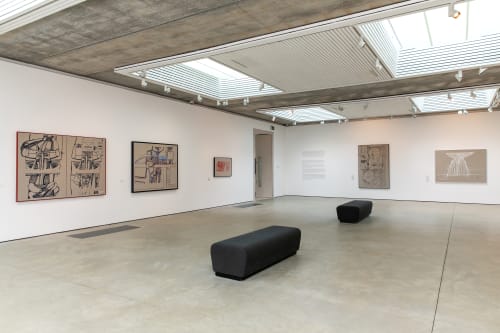When 91-year-old Ibrahim El-Salahi is drawing he gets lost in work and has temporary respite from his sciatica and chronic back pain. The ‘Godfather of African Modernism’ says it’s the only time he really has relief from the pain.
Between 2016-2018 Sudanese Oxford-based artist created an extraordinary body of work from the comfort of an armchair, refusing to let physical restriction limit his ambition. During this period, he has made around 200 tiny, but incredible, drawings in pen and ink created on the inside cardboard of his medicine packets and on the backs of envelopes after consuming their contents.
These were drawings in their own right, but they were also seeds for a very ambitious project. El-Salahi wanted to make larger scale work despite his physical constraints and achieved this by using these drawings as a nucleus from which to create large, unique mono-print paintings transferred by screen from the drawings. The original image is pressed through the gauze onto strong woven linen canvas many times over until a thick inky texture is achieved, amplifying the character of the marks. Limited by his physical constraint this method has allowed El-Salahi to do something that otherwise would not have been possible.
It is a selection of the first mono-print paintings, which will be displayed in this exhibition at Hastings Contemporary.
This approach of playing with scale and engaging the viewer is not without precedent. Throughout his career El-Salahi has returned again and again to the organic opening up of an image.
As far back as the 1950’s Ibrahim was thinking how to engage people’s attention. Disappointed by the lack of attention from his fellow countrymen and women when he showed his Slade work at the Grand Hotel in Khartoum, he noted that if he wrote something in Arabic calligraphy on the drawings it attracted interest and people paused to look and read. The words and letters slowly then evolved as he began an exploration of the pictorial qualities and hidden shapes within calligraphic forms. The pain relief imagery also now includes a nod to these early works with him making use of the pictorial possibilities of the braille on the medicine packets.
This body of work, made despite and because of circumstance, gives us the opportunity to delve into the mind of El-Salahi and experience his memories of a long and fruitful life.
El-Salahi says “I am surrounded by packets of medicine so I said ‘What a waste. Why don’t I use them?’ and I started opening them and chopping them to size and working on them. I had a number of pens with waterproof and fade proof ink, which the material of those kind of packages takes very nicely. It reminds me of the time when I found paper in prison, and did sort of little images as the nucleus. So I pray and bring peace and calm in my mind that I use as imagery, which can be transmitted to other people when they see my work.”
He added “A small drawing is an artwork by itself, but at the same time when it is enlarged it works very well indeed. It has a great potential of moving from a small size to a large size – the organic growth of a picture, the work is alive. That is the nucleus. The idea of the nucleus, like the seed, if you have water and enough sunlight it can grow into a larger size. It’s the origin, that’s the main thing.”
Hastings Contemporary Director Liz Gilmore says “Ibrahim has made an astonishing contribution to the visual arts influencing generations of artists internationally. We are thrilled, in our 10th anniversary year to commence with this beautiful and poignant exhibition of his work, coinciding with his inclusion at the Venice Biennale which opens later this month. “
In June Vigo Gallery will curate simultaneous solo exhibitions of previously unseen work created in the run up to El-Salahis Retrospective at Tate Modern at the Quadriga Galleries at Wellington Arch Museum in a pioneering partnership with English Heritage. At the same time his Pain Relief drawings will be the subject of a solo exhibition at The Norwegian Drawing Association - Tegnerforbundet which will travel in an expanded format to The Drawing Centre in New York in October. In a busy year the 91 year old will also participate in upcoming group exhibitions at the Chrysler Museum of Art (October), and the Fisk University Galleries (October).


